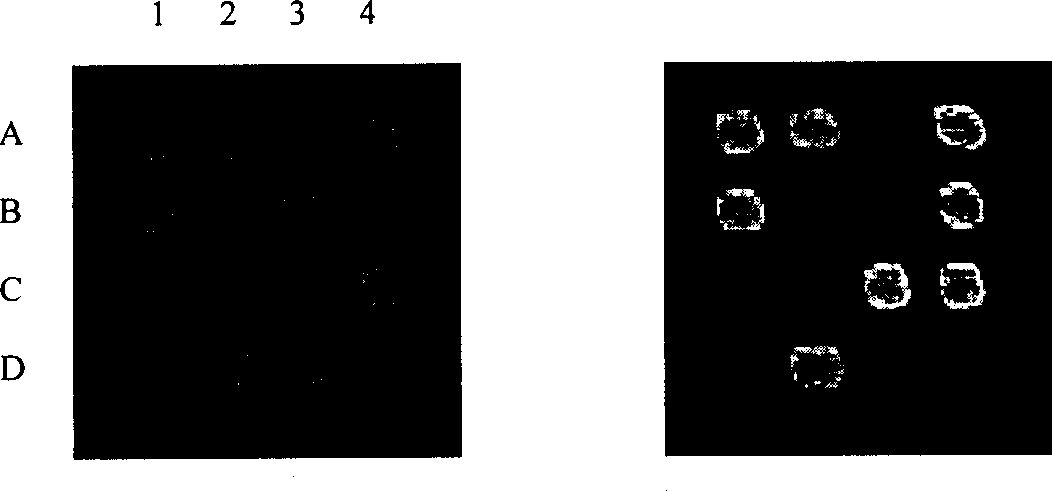Reverse protein chip
A protein chip, reverse technology, applied in the field of life sciences, can solve the problems of reducing detectable items, difficult operation, small chamber spacing, etc., to save the amount of samples to be tested, simple detection operation, and increase the scope of application Effect
Inactive Publication Date: 2002-02-13
GENETECH BIOTECH SHANGHAI
View PDF2 Cites 12 Cited by
- Summary
- Abstract
- Description
- Claims
- Application Information
AI Technical Summary
Problems solved by technology
[0003] However, first, the number of samples that can be detected by this method is limited. If it is used in a multi-sample microarray biochip, since each chamber can only detect one sample, the above technique is only suitable for several to dozens of samples detection
If there are too many chambers, the consequences are: first, the distance between
Method used
the structure of the environmentally friendly knitted fabric provided by the present invention; figure 2 Flow chart of the yarn wrapping machine for environmentally friendly knitted fabrics and storage devices; image 3 Is the parameter map of the yarn covering machine
View moreImage
Smart Image Click on the blue labels to locate them in the text.
Smart ImageViewing Examples
Examples
Experimental program
Comparison scheme
Effect test
 Login to View More
Login to View More PUM
 Login to View More
Login to View More Abstract
The present indention relates to the reverse protein chip and its preparation and detection in life science field and may be used widely in biology, medicine and related domain. In the reverse protein chip, tested protein, polypeptide or other biomolecule is fixed on solid carrier through chemical bond connection before the solid carrier is enclosed. Labeled fluorescent probe is added and made toproduce hybridization reaction with solid biomolecule, and after eluting uncombined matter, the fluorescent strength in sample point is proportional directly with the concentration of tested component. The present invention can perform multiple sample detection simultaneously.
Description
technical field [0001] The invention relates to a reverse protein chip and its preparation and detection. Protein chips belong to the field of life sciences. A protein chip is an array of proteins or polypeptides arranged in an orderly manner on a solid substrate to achieve parallel detection, identification, identification and diagnosis of proteins. Widely used in biology, medicine and related fields. Background technique [0002] The protein chip patent we applied for before, the protein chip for immunoassay (application number: 01105795.5), the main technical route is: spot the probe corresponding to the protein to be tested on the solid substrate, and then add the sample to be tested and the probe Hybridization, adding fluorescent markers, and finally judging the concentration of a certain component to be tested in the sample to be tested according to the fluorescence intensity. This method is used for the analysis and detection of antigens, antibodies or ligands, and...
Claims
the structure of the environmentally friendly knitted fabric provided by the present invention; figure 2 Flow chart of the yarn wrapping machine for environmentally friendly knitted fabrics and storage devices; image 3 Is the parameter map of the yarn covering machine
Login to View More Application Information
Patent Timeline
 Login to View More
Login to View More IPC IPC(8): G01N33/50G01N33/68
Inventor 张涛李宾彭永济任一萍
Owner GENETECH BIOTECH SHANGHAI
Features
- R&D
- Intellectual Property
- Life Sciences
- Materials
- Tech Scout
Why Patsnap Eureka
- Unparalleled Data Quality
- Higher Quality Content
- 60% Fewer Hallucinations
Social media
Patsnap Eureka Blog
Learn More Browse by: Latest US Patents, China's latest patents, Technical Efficacy Thesaurus, Application Domain, Technology Topic, Popular Technical Reports.
© 2025 PatSnap. All rights reserved.Legal|Privacy policy|Modern Slavery Act Transparency Statement|Sitemap|About US| Contact US: help@patsnap.com



